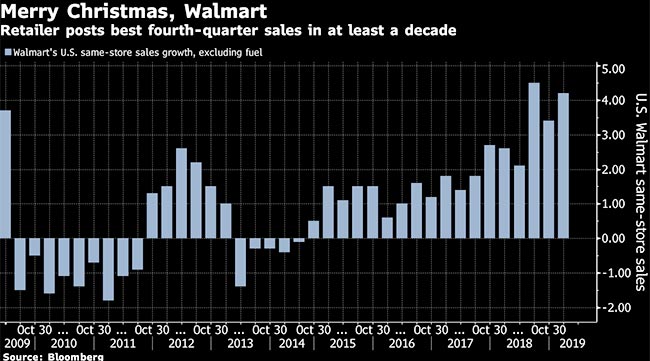Walmart Surges After Reporting Best Holiday Quarter Since 2009

Walmart Inc. finally gave the U.S. retail sector some good news.
The company brushed off the industry’s disappointing December sales with its best holiday quarter in at least a decade, soothing concerns about the sector’s outlook for 2019. Comparable sales for Walmart stores in the United States — a key performance barometer — rose 4.2% in the quarter that included Christmas, beating analysts’ estimates by a full percentage point.
“This is a blockbuster quarter for Walmart,” Moody’s analyst Charlie O’Shea said.
Shares jumped as much as 3.9% on Feb. 19 — the most in almost two months.
The strong fourth-quarter results from the world’s biggest retailer is a welcome change for a consumer sector after a bout of disappointing results. Although investors entered the holidays expecting a surge of spending, some big retailers warned sales weakened in mid-December after retailers began Black Friday promotions earlier than normal.
Walmart ranks No. 3 on the Transport Topics Top 100 list of the largest private carriers in North America.

Commerce Department figures released last week showed U.S. retail sales fell 1.2% in December from the previous month, the most since 2009 — such a big drop that some analysts questioned if the data were undercounting online sales.
Walmart shares, which rose to as high as $103.93, already had climbed 7.3% this year through close Feb. 15, compared with the 11% gain in the benchmark S&P 500.
Toy Battle
Walmart, like its rivals, made a big push to grab former Toys “R” Us shoppers during the holiday season, boosting its toy assortment by 40% online and holding thousands of in-store events at which kids could test out items. The gambit worked, as toys helped fuel the sales beat, Chief Financial Officer Brett Biggs said Feb. 19.
“There was extra share in the toy market, and we went after it,” Biggs said. Events featuring Ryan’s World, a line of toys from a YouTube toy reviewer, were especially big, he said. He declined to provide a sales figure for toys but said general merchandise sales — which also include home decor, apparel and electronics — rose by a mid-single-digit percentage in the quarter.
Walmart’s e-commerce sales in the United States rose 43%, in line with forecasts, helped by a broader assortment of brands and increased online grocery sales. This was the first holiday season for Walmart’s redesigned website, plus its expanded home delivery and curbside pickup options.
Walmart's Q4 earnings and sales topped analysts' expectations, reporting $138.79 billion in revenue. https://t.co/jjiObjyGrB pic.twitter.com/B89zvcYrkH — CNBC (@CNBC) February 19, 2019
Some Headwinds
Still, there were some potentially worrying signs in the report. Higher prices — more than increased foot traffic — drove the sales gains. Plus some of the gains in the quarter were more related to timing: The early release of government food-stamp payments that were supposed to have become available to American shoppers in February boosted U.S. same-store sales by 0.4 percentage point in the quarter, the company said.
Walmart’s profit margins also contracted slightly in the quarter as transportation and labor costs weighed on the retailer. The continued expansion of e-commerce also hurts Walmart’s profitability, as online sales typically deliver lower margins than in-store sales due to fulfillment costs.
The company reiterated the full-year sales and profit guidance it gave in October, including same-store sales growth at U.S. Walmart stores of between 2.5% and 3% — a slight slowdown from the fiscal year that just ended. Retailers are bracing for a pullback in consumer demand this year, especially if the United States follows through on its threat to more than double tariffs on many Chinese goods, forcing retailers to raise some prices in response.




